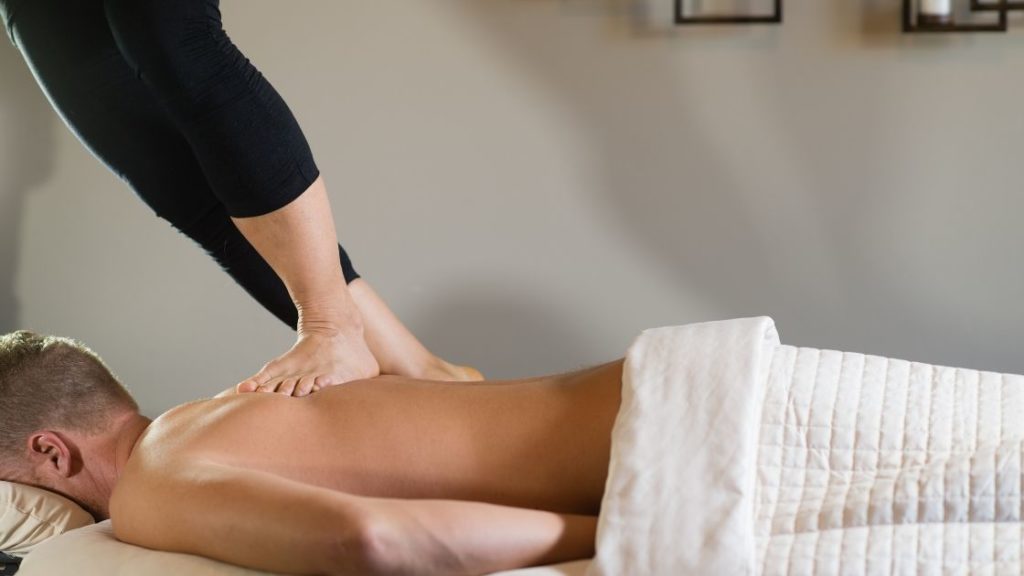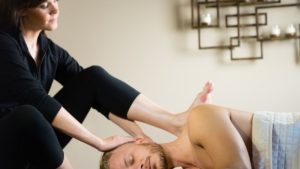What is Ashiatsu Massage?

Ashiatsu is a massage technique that involves the application of the practitioner’s feet, rather than the hands or arms, to a patient’s body. In Japanese, ashi means foot, and atsu means pressure; so it literally translates to foot pressure.
During an Ashiatsu massage, therapists use their bare feet to deliver deep compression, long gliding strokes, and/or assisted stretching. Reading that, you might feel apprehensive about receiving an Ashiatsu treatment. You may wonder if having your back walked on will be intense, painful, or even scary. Don’t worry, though! Ashiatsu therapists have full control over how your body is treated, and the massage is tailored to your needs just as a deep tissue or Swedish massage would be. So what should you expect from an Ashiatsu massage?
What to Expect During an Ashiatsu Massage
Before the session, you’ll receive a pre-consultation so the therapist can determine your body’s needs and goals. Depending on those, you may be asked to undress or remain fully clothed. If your session is going to involve the use of lotions and gliding techniques, you can expect to remove at least some of your clothing; with that said, you’ll get the most complete treatment if you remove everything, since your gluteal muscles can really benefit from some Ashiatsu gliding! Should your session only involve compression and stretching, you might be clothed the entire session, giving the treatment a Thai massage feel.
As with most massage modalities, Ashiatsu is performed on a flat massage table. You’ll most likely be asked to lie face down for the majority of the session, with a little bit of time spent face up. And no, you are not going to have your stomach stepped on while you’re face up! A supine Ashiatsu massage generally involves stretching your legs or compressing your shoulders, but you’ll get some nice gliding on your forearms and out-turned thighs/calves too!
So let’s take a few steps back to just after your pre-consultation. After you’re given time to situate yourself, your therapist will return to the massage room to begin the session. You’ll be draped securely, but expect to have each side of your body a little more exposed than it would be during a Swedish or deep tissue massage (watch the video I’ve posted below to get a look at the draping).
For an Ashiatsu massage with gliding techniques, the session may start with the application of lotion or oil. This might be the only time the therapist applies his/her hands to your skin. If you’re fully clothed, the session will lightly start with compression. Following the introductory strokes, your therapist will suspend his or herself above your body through the use of ropes or bars attached to the ceiling. The equipment installed above allows a therapist to balance oneself and control the amount of body weight applied. The practitioner will let the heels, arches, and balls of the feet sink into your muscles, and from there you’ll communicate the right amount of pressure. Just like with any massage, you’ll likely have areas of the body that can handle more pressure than others. So always be communicative and honest about what you need.
While most Ashiatsu techniques are assisted by the use of bars and ropes, the massage can also be performed with the therapist seated on a chair. Certain parts of your body, such as the shoulders or calves, may be stretched or compressed while the therapist sits on a stool and pushes his/her feet into the area.
Here is an excellent video of an experienced Ashiatsu therapist doing her thing! The narrator gives the wrong translation for the word Ashiatsu, but everything else here is spot on! If you’re like me, the way this therapist moves will encourage you to book your first ever Ashiatsu massage!
Benefits of Ashiatsu Massage
- Relieves pain
- Reduces stress
- Increases flexibility
- Improves posture
- Boosts circulation
- Enhances athletic performance
- Promotes restful sleep
An Ashiatsu massage provides the same benefits as a deep tissue massage. Ashiatsu, however, can deliver the deepest pressure a massage can offer, even though it by no means has to. If you’re one of those people who prefers very deep pressure and you’ve yet to find a therapist who can go just that deep, try Ashiatsu! As an avid fan of deep tissue massage with extra deep pressure, I speak from experience when I say Ashiatsu is amazing!
Now You Know!
Moyer Total Wellness is now offering Ashiatsu massage! Book an appointment today!

Katrina Jenkins
Author, Licensed Massage Therapist
Katrina Jenkins graduated from Towson University in 2013 with a Bachelor’s Degree in Health Science and worked as a nurse’s aide briefly before pursuing her true passion. She graduated from the Massage Therapy Institute of Colorado in April 2016 with honors and completed the Touch of Healers Scholarship Program the following summer. She has been a part of the Moyer Total Wellness Team since the summer of 2017.
Works Cited
“Ashiatsu History | Ashiatsu Massage | Ashiatsu Certification.” Barefoot Trainer’s Ashiatsu, www.ashiatsutraining.com/ashiatsu-history/massage-classes. Accessed 15 Apr. 2021.
Ivy. “What Is Ashiatsu?” Ashiatsu Barefoot Massage, 19 Apr. 2012, www.ashiatsu.net/what-is-ashiatsu/. Accessed 15 Apr. 2021.
Sissons, Beth. “Deep Tissue Massage: Benefits, Risks, and What to Expect.” Www.medicalnewstoday.com, 24 Nov. 2020, www.medicalnewstoday.com/articles/deep-tissue-massage-benefits.
Photo Credit
Canva by WhitneyLewisPhotography
Canva by WhitneyLewisPhotography

